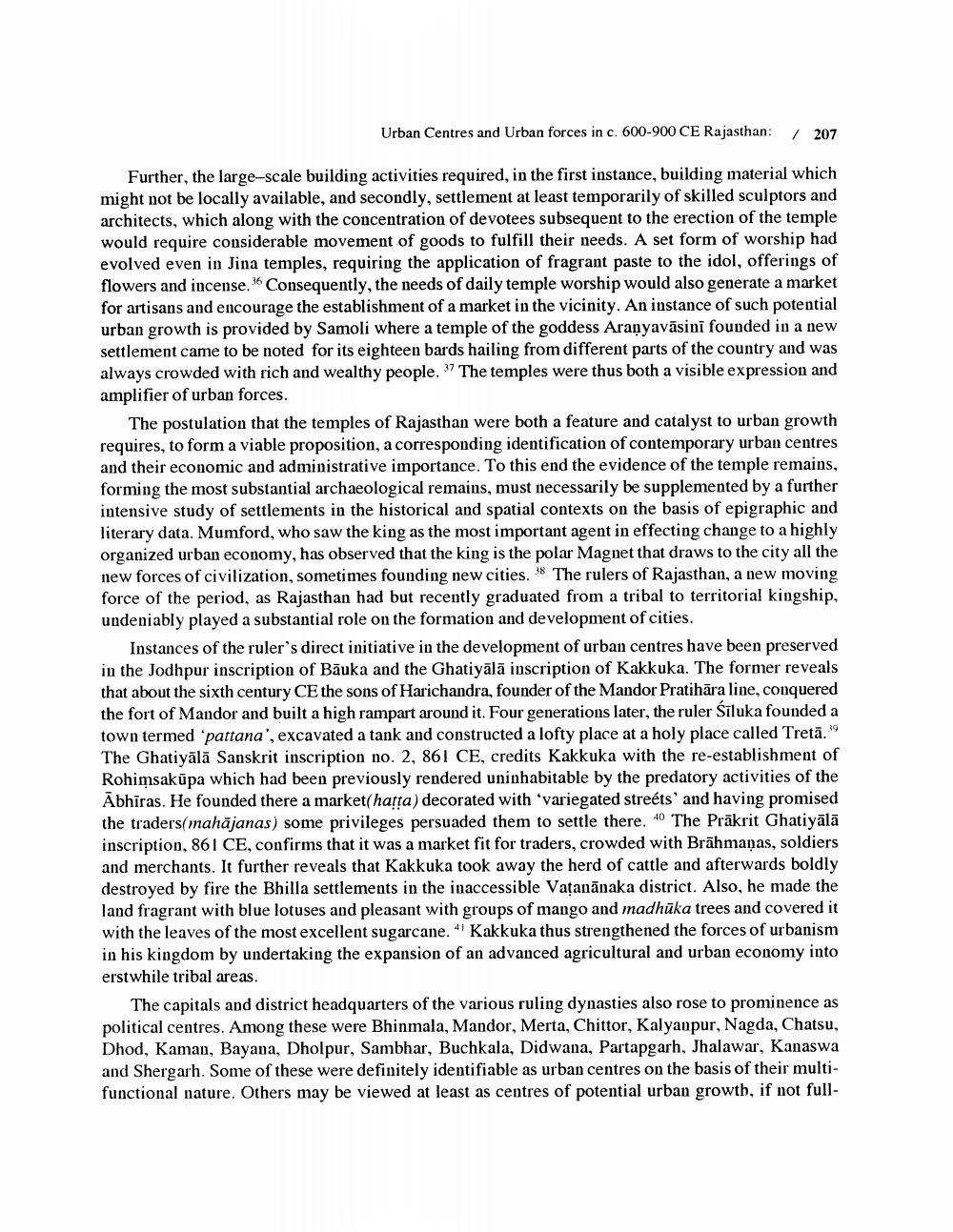________________
Urban Centres and Urban forces in c. 600-900 CE Rajasthan: / 207
Further, the large-scale building activities required, in the first instance, building material which might not be locally available, and secondly, settlement at least temporarily of skilled sculptors and architects, which along with the concentration of devotees subsequent to the erection of the temple would require considerable movement of goods to fulfill their needs. A set form of worship had evolved even in Jina temples, requiring the application of fragrant paste to the idol, offerings of flowers and incense. 36 Consequently, the needs of daily temple worship would also generate a market for artisans and encourage the establishment of a market in the vicinity. An instance of such potential urban growth is provided by Samoli where a temple of the goddess Aranyavasini founded in a new settlement came to be noted for its eighteen bards hailing from different parts of the country and was always crowded with rich and wealthy people. "The temples were thus both a visible expression and amplifier of urban forces.
The postulation that the temples of Rajasthan were both a feature and catalyst to urban growth requires, to form a viable proposition, a corresponding identification of contemporary urban centres and their economic and administrative importance. To this end the evidence of the temple remains, forming the most substantial archaeological remains, must necessarily be supplemented by a further intensive study of settlements in the historical and spatial contexts on the basis of epigraphic and literary data. Mumford, who saw the king as the most important agent in effecting change to a highly organized urban economy, has observed that the king is the polar Magnet that draws to the city all the new forces of civilization, sometimes founding new cities. 38 The rulers of Rajasthan, a new moving force of the period, as Rajasthan had but recently graduated from a tribal to territorial kingship, undeniably played a substantial role on the formation and development of cities.
Instances of the ruler's direct initiative in the development of urban centres have been preserved in the Jodhpur inscription of Bauka and the Ghatiyala inscription of Kakkuka. The former reveals that about the sixth century CE the sons of Harichandra, founder of the Mandor Pratihāra line, conquered the fort of Mandor and built a high rampart around it. Four generations later, the ruler Siluka founded a town termed 'pattana', excavated a tank and constructed a lofty place at a holy place called Tretā. " The Ghatiyālā Sanskrit inscription no. 2, 861 CE, credits Kakkuka with the re-establishment of Rohimsakupa which had been previously rendered uninhabitable by the predatory activities of the Abhiras. He founded there a market(haṭṭa) decorated with 'variegated streets' and having promised the traders(mahajanas) some privileges persuaded them to settle there. 40 The Prakrit Ghatiyālā inscription, 861 CE, confirms that it was a market fit for traders, crowded with Brāhmaṇas, soldiers and merchants. It further reveals that Kakkuka took away the herd of cattle and afterwards boldly destroyed by fire the Bhilla settlements in the inaccessible Vaṭananaka district. Also, he made the land fragrant with blue lotuses and pleasant with groups of mango and madhūka trees and covered it with the leaves of the most excellent sugarcane. 41 Kakkuka thus strengthened the forces of urbanism in his kingdom by undertaking the expansion of an advanced agricultural and urban economy into erstwhile tribal areas.
The capitals and district headquarters of the various ruling dynasties also rose to prominence as political centres. Among these were Bhinmala, Mandor, Merta, Chittor, Kalyanpur, Nagda, Chatsu, Dhod, Kaman, Bayana, Dholpur, Sambhar, Buchkala, Didwana, Partapgarh, Jhalawar, Kanaswa and Shergarh. Some of these were definitely identifiable as urban centres on the basis of their multifunctional nature. Others may be viewed at least as centres of potential urban growth, if not full




